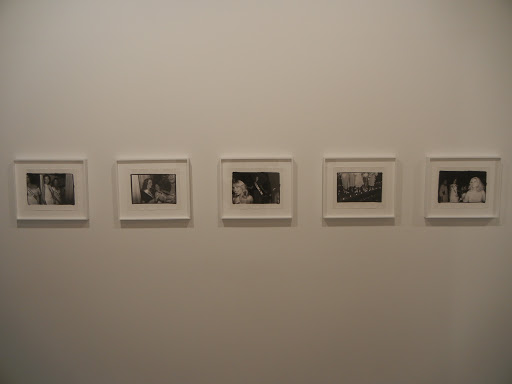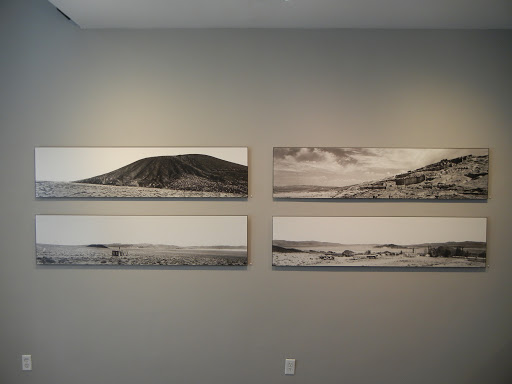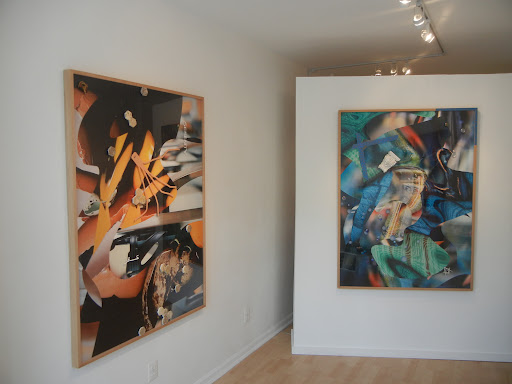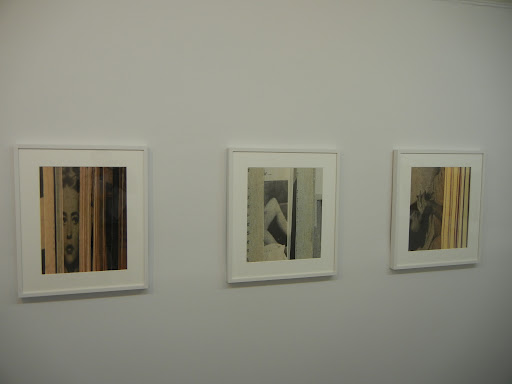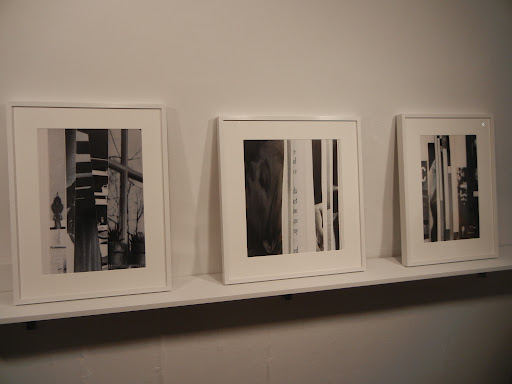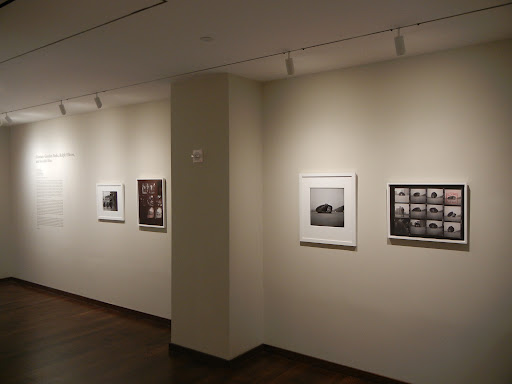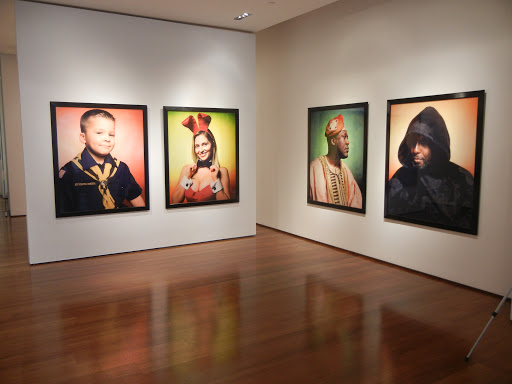 JTF (just the facts): A total of 19 large scale color photographs, framed in black and unmatted, and hung against white walls in the entry and the divided gallery space. All of the works are Cibachrome prints with silicone and acrylic, made between 1987 and 2002. The prints on view range in size from 40×28 to 60×50 (or reverse) and are available in editions of 3, 4, 7, and 10, depending on the series. The show was curated by Walter Robinson. (Installation shots at right.)
JTF (just the facts): A total of 19 large scale color photographs, framed in black and unmatted, and hung against white walls in the entry and the divided gallery space. All of the works are Cibachrome prints with silicone and acrylic, made between 1987 and 2002. The prints on view range in size from 40×28 to 60×50 (or reverse) and are available in editions of 3, 4, 7, and 10, depending on the series. The show was curated by Walter Robinson. (Installation shots at right.)
Comments/Context: If we were to gather together the names of the most controversial photographers in the history of the medium, Andres Serrano would certainly be on the short list. While his now infamous Piss Christ would have singlehandedly been enough to earn him a coveted spot on the team, his entire artistic career has been full of provocative, often challenging, and sometimes disturbing work. Many viewers have been deeply offended by Serrano’s imagery, and he has been roundly and repeatedly condemned over the years. In project after project, he has pushed the boundaries of acceptability and taste, confronting a litany of taboos, religion, race, and death being just a few of the highly charged subjects he has openly tackled. The consistency of his point of view across the decades has in many ways worked against him I think; it has turned many people off before they even bothered to look closely. Prior to this show, I will certainly admit to having offhandedly dismissed him as a shock for shock’s sake grandstander, an opinion I unfortunately derived mostly from others rather than from my own experience of the work.
 One of the unexpectedly important things to come from writing about photography on a daily basis has been that it has forced me out my own safe, self-fulfilling bubble of seeing things I already know I will like, dragging me to shows I would have never gone to otherwise. While I have of course encountered plenty of individual Serranos at auctions, art fairs, and museums over the years, this was the first time I had actively engaged an entire gallery show full of his work. The exhibit spans the last three decades, bringing together a mini-sampler from some of his best known series.
One of the unexpectedly important things to come from writing about photography on a daily basis has been that it has forced me out my own safe, self-fulfilling bubble of seeing things I already know I will like, dragging me to shows I would have never gone to otherwise. While I have of course encountered plenty of individual Serranos at auctions, art fairs, and museums over the years, this was the first time I had actively engaged an entire gallery show full of his work. The exhibit spans the last three decades, bringing together a mini-sampler from some of his best known series.
Every individual body of work on view here finds its own way to upend and unsettle, testing limits and forcing uncomfortable dialogues. A swirling bubbled abstraction from the Bodily Fluids series is made of semen and blood, a smiling African-American man is dressed in a pointed Ku Klux Klan robe, a pair of serene folded hands turn out to belong to an AIDS corpse from The Morgue series, and homeless people are photographed with the rugged glamour of a fashion shoot in three images from Nomads. I now understand both the knee-jerk reaction of finding these images deplorable and a contrasting view which finds them thoughtfully out on the edge. The late 1980s Immersion series, which is represented here by Piss Christ as well as images of the Madonna, Moses, a discus thrower and the baby Jesus, walks this same bright line, at once confrontationally crass and surprisingly vital. And a group of pictures from the more recent America series traverses a variety of societal stereotypes via uniforms and clothing, starting with the All-American fireman and boy scout, continuing with a procurement analyst and investment bank sales assistant in unexpectedly traditional African garb, and closing with a Playboy bunny and a covert to Islam in headscarf and veil. Serrano is reminding us that they are all “America”; sure they’re heavy handed and exaggerated, but his point about diversity is succinctly delivered.
 I can’t say that I came away from this show a Serrano fan; I still find too many moments in his work where the effect seems too self-consciously outrageous. But the best of these works deserve respect for the real thrumming electricity that he has managed to create. We all know that he’s actively pushing our buttons and trying to get a rise out of us, but realizing that, if he can still successfully get us to stop and think once in a while, isn’t that what art is all about?
I can’t say that I came away from this show a Serrano fan; I still find too many moments in his work where the effect seems too self-consciously outrageous. But the best of these works deserve respect for the real thrumming electricity that he has managed to create. We all know that he’s actively pushing our buttons and trying to get a rise out of us, but realizing that, if he can still successfully get us to stop and think once in a while, isn’t that what art is all about?
Collector’s POV: The prints in this show range in price from $22000 to $120000, with most between $30000 and $40000; Piss Christ is on loan and NFS. Serrano’s work is consistently available in the secondary markets, with recent prices ranging from roughly $5000 to $160000.
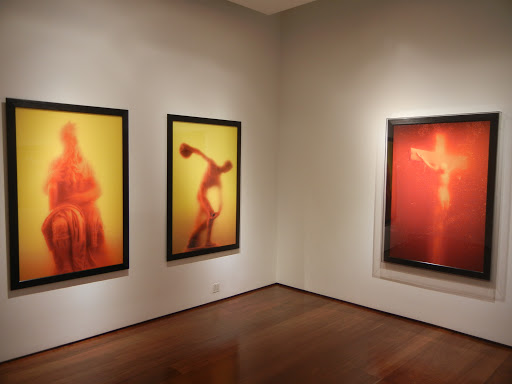 Rating: * (one star) GOOD (rating system described here)
Rating: * (one star) GOOD (rating system described here)
Transit Hub:
- Features/Reviews: New Yorker (here), Huffington Post (here), NY Post (here)
Body and Spirit: Andres Serrano 1987-2012
Through October 26th
Edward Tyler Nahem Fine Art
37 West 57th Street
New York, NY 10019
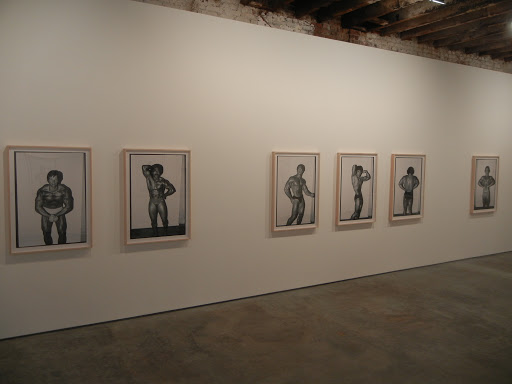 JTF (just the facts): A total of 28 black and white photographs, framed in bond wood and unmatted or framed in white and mounted, and hung against white walls in the divided gallery space. The images in the show were taken in 1978 and 1979. The 13 prints in the front gallery area are modern light jet prints, each sized 40×29, in editions of 3+1AP. The 15 prints in the back gallery area are vintage gelatin silver prints, each sized 16×19; these prints are unique. (Installation shots at right.)Comments/Context: Looking at Daniel Joseph Martinez’ photographs in this show is a little like traveling back in time to the Southern California of the late 1970s. But while these images are rich in details and atmosphere from that period, this smart pairing of two complementary projects (male body builders and female beauty pageant contestants) opens up a complex conversation about the extremes of human body image that continues today.
JTF (just the facts): A total of 28 black and white photographs, framed in bond wood and unmatted or framed in white and mounted, and hung against white walls in the divided gallery space. The images in the show were taken in 1978 and 1979. The 13 prints in the front gallery area are modern light jet prints, each sized 40×29, in editions of 3+1AP. The 15 prints in the back gallery area are vintage gelatin silver prints, each sized 16×19; these prints are unique. (Installation shots at right.)Comments/Context: Looking at Daniel Joseph Martinez’ photographs in this show is a little like traveling back in time to the Southern California of the late 1970s. But while these images are rich in details and atmosphere from that period, this smart pairing of two complementary projects (male body builders and female beauty pageant contestants) opens up a complex conversation about the extremes of human body image that continues today. Martinez’ body builders have been captured just off stage before a competition. They stand flash lit against a simple white backdrop (almost Avedon style), strutting and posing, but doing so with a bit more relaxed naturalness than they might exhibit in the heat of battle. Exaggerated muscular bodies ripple in the bright light, their curves accented by a sheen of oil. Obvious pride mixes with oversized freakishness in an over-the-top display of survival of the fittest strength taken to the limits of plausibility. There is something both impressive and sadly desperate about the life these pictures depict.
Martinez’ body builders have been captured just off stage before a competition. They stand flash lit against a simple white backdrop (almost Avedon style), strutting and posing, but doing so with a bit more relaxed naturalness than they might exhibit in the heat of battle. Exaggerated muscular bodies ripple in the bright light, their curves accented by a sheen of oil. Obvious pride mixes with oversized freakishness in an over-the-top display of survival of the fittest strength taken to the limits of plausibility. There is something both impressive and sadly desperate about the life these pictures depict. Both bodies of work push hard on the underlying societal why of such behavior, both on the level of the individual and in the broader cultural context. They combine a documentary process with a conceptual overlay, capturing the genuine effort and the subtle comedy of these unnatural bodies and situations. While the scenes may seem plucked from times long gone, the underlying ideas are remarkably fresh and vibrant. Decades later, we’re still modifying our bodies, in ever more extreme ways, and Martinez’ 1970s critique still hits home.
Both bodies of work push hard on the underlying societal why of such behavior, both on the level of the individual and in the broader cultural context. They combine a documentary process with a conceptual overlay, capturing the genuine effort and the subtle comedy of these unnatural bodies and situations. While the scenes may seem plucked from times long gone, the underlying ideas are remarkably fresh and vibrant. Decades later, we’re still modifying our bodies, in ever more extreme ways, and Martinez’ 1970s critique still hits home.